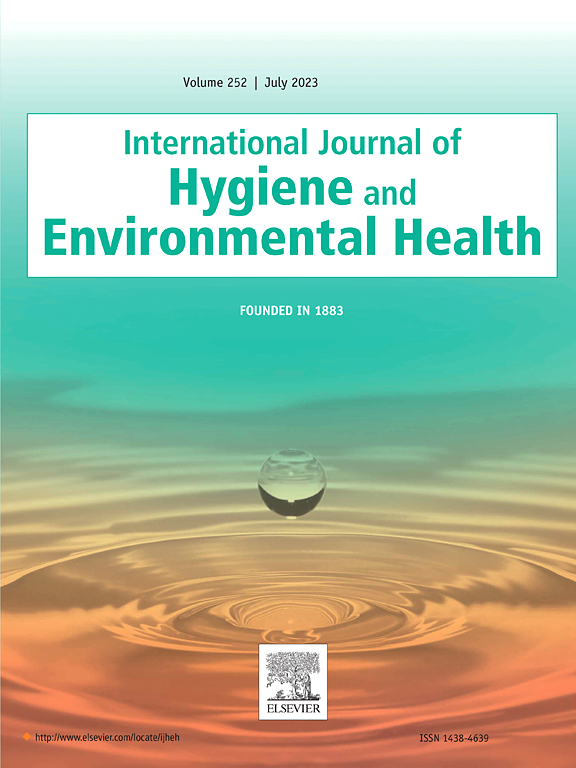Assessing the association between prenatal ambient temperature and extreme low birth weight in South Asia
IF 4.4
2区 医学
Q1 INFECTIOUS DISEASES
International journal of hygiene and environmental health
Pub Date : 2025-05-18
DOI:10.1016/j.ijheh.2025.114593
引用次数: 0
Abstract
Background
Previous studies have suggested the negative effects of exposure to high temperature during pregnancy on multiple adverse birth outcomes. However, there is a lack of evidence regarding the exposure-response relationship and future risk projections for extreme low birth weight (ELBW) in South Asia.
Methods
A total of 393,530 pregnant women from Bangladesh, India, Nepal, and Pakistan were included in this analysis. Annual mean temperature throughout each woman's entire gestational period was estimated from the fifth generation of the European Re-Analysis Land Dataset (ERA5-land). We employed the multivariable mixed effect regression model, incorporating random effects for survey strata, to assess the relationship between temperature and ELBW.
Results
Stepwise regression models show robust and monotonically varying exposure-response relationships. In the fully adjusted model, for every 1 °C increase in temperature, the risk of ELBW may increase by 1.41 % (95 % CI: 0.99 %, 1.85 %), while birth weight may decrease by −2.26 g (95 % CI: 3.47, −1.04). We found that 2.25 % (95 % CI: 1.26 %, 3.25 %) of ELBW risk can be attributed to annual mean temperature in South Asia, with India having the highest attributed risk (AF = 3.01 %, 95 % CI: 2.48 %, 3.53 %), followed by Bangladesh (AF = 2.81 %, 95 % CI: 2.32 %, 3.29 %). Several environmental, maternal, and household factors may modify the relationship between ambient temperature and ELBW. The risk of ELBW related to temperature rise would increase in the future, especially under the unrestricted emission scenario (e.g. SSP585).
Conclusions
In South Asia, greater risks and burdens of ELBW were observed with increasing prenatal ambient temperature. A deeper understanding of covariant factors and intervention measures were needed to address maternal and child health issues under climate change.
评估南亚产前环境温度与极低出生体重之间的关系
以往的研究表明,怀孕期间暴露于高温会对多种不良分娩结果产生负面影响。然而,关于南亚极低出生体重(ELBW)的暴露-反应关系和未来风险预测缺乏证据。方法对来自孟加拉国、印度、尼泊尔和巴基斯坦的393530名孕妇进行分析。每个妇女整个妊娠期的年平均温度是根据第五代欧洲重新分析土地数据集(ERA5-land)估计的。我们采用多变量混合效应回归模型,结合调查层的随机效应,评估温度与ELBW之间的关系。结果逐步回归模型显示稳健且单调变化的暴露-反应关系。在完全调整模型中,温度每升高1°C, ELBW的风险可能增加1.41% (95% CI: 0.99%, 1.85%),而出生体重可能减少- 2.26 g (95% CI: 3.47, - 1.04)。我们发现,南亚地区2.25% (95% CI: 1.26%, 3.25%)的ELBW风险可归因于年平均温度,其中印度的归因风险最高(AF = 3.01%, 95% CI: 2.48%, 3.53%),其次是孟加拉国(AF = 2.81%, 95% CI: 2.32%, 3.29%)。一些环境、母亲和家庭因素可能会改变环境温度与腰重之间的关系。未来与温度升高相关的ELBW风险将增加,特别是在无限制排放情景下(例如SSP585)。结论在南亚地区,随着产前环境温度的升高,新生儿外胎妊娠的风险和负担增加。需要更深入地了解协变因素和干预措施,以解决气候变化下的妇幼健康问题。
本文章由计算机程序翻译,如有差异,请以英文原文为准。
求助全文
约1分钟内获得全文
求助全文
来源期刊
CiteScore
11.50
自引率
5.00%
发文量
151
审稿时长
22 days
期刊介绍:
The International Journal of Hygiene and Environmental Health serves as a multidisciplinary forum for original reports on exposure assessment and the reactions to and consequences of human exposure to the biological, chemical, and physical environment. Research reports, short communications, reviews, scientific comments, technical notes, and editorials will be peer-reviewed before acceptance for publication. Priority will be given to articles on epidemiological aspects of environmental toxicology, health risk assessments, susceptible (sub) populations, sanitation and clean water, human biomonitoring, environmental medicine, and public health aspects of exposure-related outcomes.

 求助内容:
求助内容: 应助结果提醒方式:
应助结果提醒方式:


